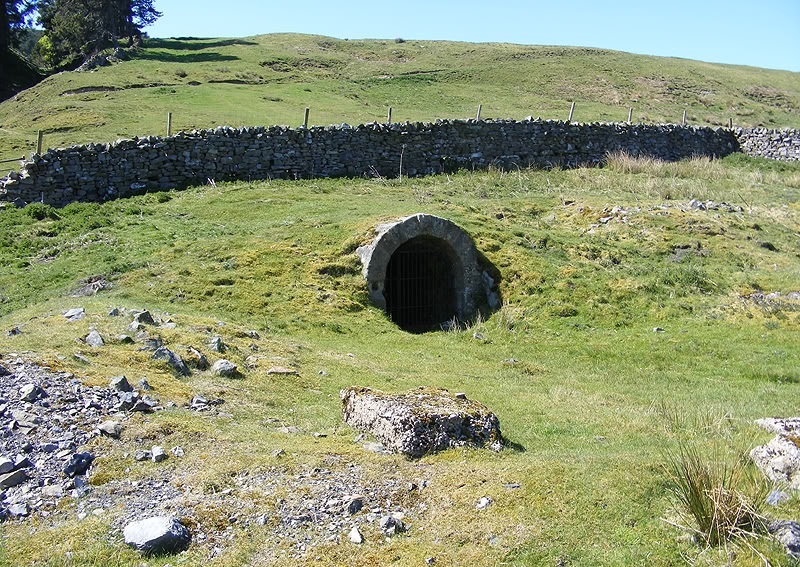
Announcement Date: May 11, 2013
MODERATE UNDERGROUND – Once inside the mine it was necessary to wade shin deep through water of foot-numbing coldness. After only a short period of adjustment, however, feeling returned to our feet and, comfort restored, there was much to absorb our interest and divert attention from potential dangers and discomforts.
Moulds Old Level was originally driven about 1800 but in the 1920s the mine was re-opened and worked for chert. Evidence of this is apparent in the form of
large blocks of chert lying on the floor of a side chamber. Some blocks had evidently been levered from the roof which is now supported (just!) by old and half-rotten timber props and wedges.
In the bare rock walls of the main level, close to the entrance, shot holes, apparently drilled by a power tool rather than a hand drill, may belong to this later phase of mining. Elsewhere the high quality of the arched masonry lining of the level is very striking and evidently the work of highly skilled masons. The shaped
sandstone blocks carefully fitted together to form a slightly pointed arch, just high enough for a man to stand upright in the centre if allowance is made for the
layer of silt and debris that has accumulated since the mine stopped working.
Paul explained how the masonry lining is restricted to areas close to the entrance where the rock overhead is thin or has been fractured by frost and weathering, and to other areas of ‘incompetent’ rock (such as shale) which are liable to collapse, although being softer are relatively quick, and therefore cheap to drive through.
Where there is limestone, the rock is harder and no lining is needed, and the only reinforcement here is provided by occasional timber props or wedges, or lengths of old iron rail held in place Underfoot, wooden sleepers, now half buried in the floor, supported the iron rails on which tubs loaded with ore or waste rock once ran. As Paul explained, the early rails, being made of cast rather than wrought iron, were brittle and to compensate for the downward pressure exerted by the heavy tubs were of ‘fish-belly’ design, with a deeper profile in the middle than at the ends.
Beyond the chert workings, debris from a number of collapses partially obstructed progress. In some cases this could be negotiated only by crawling flat on one’s belly in a manner first learned as a CCF cadet almost half a century ago. In one section a ‘false floor’, bridged over with timber and a coating of mud and rubble, has partially collapsed revealing a drop of three or four metres into a cavity below.
Advance warning of the danger is provided by red and white plastic tape stretched across the floor at either end. Elsewhere worrying bulges in the masonry lining, or piles of loose rubble spilling out from openings in the roof and walls, similarly serve as reminders that a mine is a potentially dangerous and always dynamic environment, the more so once regular maintenance has ceased. What was accessible even in the recent past may not be so now or in the near future. While it is said that it was once possible to walk underground from the Sir Francis Level in Gunnerside Gill all the way through to Moulds – a distance of not less than 6 kms – it is certainly not possible to do so now.
Two or three hundred metres into the mine the level splits to form two divergent passages, each having several other branches. Here only experience can tell which routes are safe or can be explored for the greatest distance. I was reminded of an excursion into the catacombs in Rome made many years ago where I had the same anxiety about how, in an emergency, one might find one’s way out without experienced help.
In the area we explored, evidence of mineralisation and of the working of ore deposits was very limited. Where veins had been stoped out the resulting voids disappear into darkness overhead or underfoot. Even with the benefit of modern helmet lights the character of the different minerals is hard to determine, especially to the untrained eye. All the more reason, therefore, to admire the expertise of the miners who, lacking any formal training in geology and with only the benefit of candlelight, were able to distinguish the different minerals by colour, touch and apparently even taste.
Over the course of two and half hours underground there was much well-informed comment and discussion on mining and related matters. The names of Dunham, Raistrick, Gill and Tyson were frequently invoked, and personal anecdotes and experiences in other mines freely shared and discussed. By good fortune the party included several members with professional experience in the fields of engineering and chemistry which added further to the interest and enjoyment of the trip.

